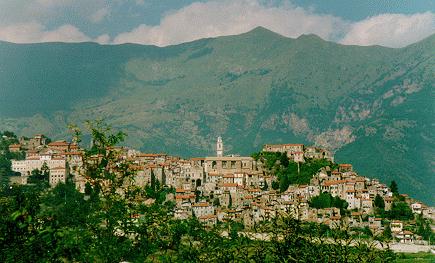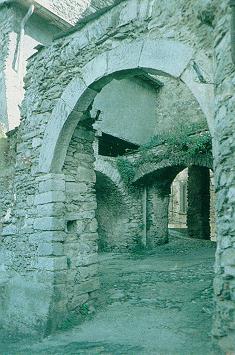
all data refer to year 2000
 |
| Off the beaten track |
| Triora - Village of narrow lanes and witchcraft all data refer to year 2000 |
This page is in memory of
my Grandmothers and Grandfhaters.
This document contains both my impressions and a formal report about the village.
The Voice of Soul
If you arrive in Triora just after the sunset or in a rainy or foggy day you
feel at once to be in a magical place.
Between the lanes that we, Ligurian people, call
carügi, you can still hear the voice of silence or
the sudden noise produced by a black and lonely cat which is strolling around.
Life still flows slowly here, far away from big and crowded places. Somewhere
you can see the soft light of a little lamp twinkles through the steamy windows
and some shadows move behind them.
Sometime the silent is broken by the soft and echoed trot of a mule or a donkey,
but as soon as you can see it, it disappears, shadow amidst shadows, along the
labyrinth of narrow lanes. It seems so easy to get lost between the tall black
houses crowded together, lanes crossed by arches, the flights of steps and the
underground caverns. Stepping out, fountains and public washhouses are the last
memories of a not so far past when agriculture and breeding was the only richness
of this kind of small country towns. If you listen by the ears of the fantasy
you can still hear the sound produced by undreds hoof of sheep and goats, or the
happy songs of the washerwomen.
All along the lanes there are ancient workshops where people sell cheese, the
famous "Bread of Triora", books, postcards, food.
Taking a look around you discover that everything is made of rocky briks, wood
and slate, the dark grey stone used to roof houses, to build stairs and chais or
to decorate the door slabs.
Sometime the figures carved on the slabs placed
above the doors seem to stare at you with their serious faces, sometime it is almost
impossible to understand the meaning of the signes carved on slate... Signes belonging
to Celtic-Ligurians shaman tradition or belief on witches and witchcraft....
Witches and Witchcraft, dark presences... This Triora is also famous
for.
The red line of the sunset is leaving the place to the night. There is nothing
more nice to see than the twilight while the valley below resonates of the sounds
of the bells of churches.
The long shadows of the walls and arches crossing lanes fade away and you feel
alone just near the place called "La Cabotina",
the place avoided by everyone after the twilight.
"La Cabotina" is the extreme part of Triora village and situated
on a steep escarpment amidst a forest of pines, chestnuts and beeches. There is
a flavour of magic in that was supposed to be the residence of the "Witches
of Triora". A mystical silence is the master of the ruins of a group of
about ten houses eaten by ivy and blackberry bushes. Inside the tumbledown houses, at the light of a pale lamp, there are only few memories
of the poor women lived there: a fireside, a broken chair or table, a window without glasses,
a crashed door. Time stopped to flow 4 centuries ago, after the massacre.
The whistle of the wind passing through the windows and the rustling of the leaves
make you have goose pimples and each time you hear a sudden noise behind the cornes
the heart start to beat fast, remembering that far day of the 1587, when a special
commisar in the vest of Vicar of Inquisition start to burn more than 50
women who lived here, accused of witchcraft.
The strange and unaspected jingle coming from the last house makes you realize
that something strange is going to happen. A dark shadow crosses fast the lane.
You start to freeze as soon as an uncertain light is switched on, but the fear
fades away as fast as it has came: the last house of "La Cabotina"
is a nice shop named "La Grande Foresta" (The Big Forest) where
a small group of craftwomen produce objects made of clay. Inside, the shop
fornitures are made of wood, a big window offers a spectacular view of the valley
and a big stove maintains warm the place during the winter. Everywhere on the
set of shelves there are Trolls, Dwarves, boxes and candelabras of various colors,
shapes and size, incense and essences burners and many other little objects
belonging to Celtic Tradition. A soft New Age melody comes from a couple of hidden
speakers. The seller is not a witch at all, but a very kind, handsome and lovable
blonded girl with two big sparkling blue eyes who greet people with a soft and
calm voice.
So what about the witches? The voices about the strange presences are only tales?
May be, but well then why cats and other animals avoid that place? In November, as
the fog or low clouds wrap up the small village, what are those strange black
dressed figures who move fast along the lanes, without doing noise, like gosths?
Who laughes so loud and who lightes fires in "La Cabotina"
without leaving any trace the day after? Ask people who live in Triora, the answer
is always the same, told by low voice, like a whisper: the souls of the witches
burned in the 16th century.
So remember... Never be alone near "La Cabotina" after the twilight.
Triora at a Glance
Triora rises west of Sanremo (about 25 Km away as the bird flies) 776 m above sea level.

The town, which faces southwards and dominates the outlet of the Argentina Valley, is completely medioeval and concerves traces of the old Celtic-Ligurian villages. Characteristic are the caves and portico's, the tall black houses crowded toghether, the lanes crossed by arches, the flights of steps and the underground caverns.
History
Triora is an ancient town who's origins are pratically unknown. All that in known
is that after being owened by the Aleramici it passed under the Arduinic standard
and later under the Counts of Ventimiglia.
In a document dated the 18th March 1202 Triora is dipicted as a fortress
which bound alliances with the villages on the nearby valleys.
In 1200, although still belonging to the Counts of Ventimiglia, Triora had acquired
half of the fortress of Dho (the Celt name of the
village later named Castelfranco and finally Castelvittorio in homage to the first king
of Italy).
On the 21st of February 1260 Triora was sold by Bonifacio Count of Badalucco
and son of Oberto, Count of Ventimiglia, to one of his brothers in law who sold
it to the Commune of Genoa.
Passed under Genoa, Triora was promoted head of a jiurisdiction with a Governer:
it's jiurisdiction extended over the villages of Bajardo,
Dho, Ceriana, Montalto and Badalucco and also had the prerogative to inflict death penalty.
Triora rebelled against Genoa but was defeated and since then became a faithful
ally.
In the XV century the Mens General Parliament of Triora drew up their own statutes
(reformed in the following century) basing the life of the town on them.
The standard life in Triora during the XIV century must have been quite high going
by the number of works of art (portals, inscriptions, casts of arms) and the number
of illustrious men, expecially men of letters. Unfortunately this century also
brought other non so edifyng things such as the belief in sortilege and
witchcraft. The first case was recorded in October 1587: the genoese
government immediately sent a special commisar in vest of Vicar of the
Inquisition.
The territory of Triora has often been a theatre of war: 1625 and 1671 between Genoa
and Savoia; 1794 between the Kingdom of Sardinia and France.
The jiurisdiction that Triora received from Genoa lasted up untill the Declaration
of the Republic of Liguria (1797 March 31st) when Napoleon dissolved it
and the town was riunited to the French Empire (1805). After the defeat of Napoleon
Genoa was ceded by France to the Kingdom of Sardinia and Triora passed definitely
under the house of Savoia.
About the Village
Slate has forever given the people af Triora the "ciape"
(square tiles made of stone) to roof their houses, to build stairs and chairs and
to decorate the door slabs which can still be seen today. The artisans have left
door-posts and sculptures which seems to want ingentle the narrow alleys of the
town. Unfortunately many of these were abrased in 1797 during the period of Ligurian
Republic.
 Among the slabs placed
above the doors, particularly embelleshed are those in Vicolo (alley) Zunzelli such as
the figure of a man with an austere face and long hair, beard and mustache, in Via
(street) Sambuglia (The Annunciation, probably engraved in the XV century), the City Gate
of Largo (square) Tamagni (which dipicts two seated lions flanking a coat of arms), and the
15th century gate in Piazza (place) della Collegiata.
Among the slabs placed
above the doors, particularly embelleshed are those in Vicolo (alley) Zunzelli such as
the figure of a man with an austere face and long hair, beard and mustache, in Via
(street) Sambuglia (The Annunciation, probably engraved in the XV century), the City Gate
of Largo (square) Tamagni (which dipicts two seated lions flanking a coat of arms), and the
15th century gate in Piazza (place) della Collegiata.
Also in slate are the little columns typical of the entrances to the wealthier
houses.
On the external wall of the parish (Via Giauni) one may admire a bust, sculptured
in stone (1555) of a franciscan monk clutching a pair of glasses in his right
hand.
 The town of Triora was
built in an easly defendible position but in case of need it was rendered even more secure
by walls and fortifications.One could enter the town through five different Gates,
(now almost entirely dismantled) which were close by heavy bars at night.
The town of Triora was
built in an easly defendible position but in case of need it was rendered even more secure
by walls and fortifications.One could enter the town through five different Gates,
(now almost entirely dismantled) which were close by heavy bars at night.
At the Gate of the High Fountain, so called for the presence of an ancient
fountain, one may still admire a stone arch, an embrasure used for defence against
the enemy, and the small entrance (now walled up) to the exciseman's room. Inside
it is possible to admire intersecting arches and vaults which form a play of lights
underlining the bauty of these ancient constructions.
The Gate Peirana, so named because it linked the town to the church
of St. Peter, of which today there is no trace.
It was the principal entrance to te town and the oldest gate of Triora ad demonstrates
the ogival form of its arch. The gate was destroyed during the 2nd
Word War.
Gate Anfossa which leads to the church os St. Bernardino.
Gate Colombera, situated in the lower part of the town it was moved further
uphill after a siege.
The fifth gate who had no name was near the castle.
Of the existing five Fortresses only a few ruins remain.
At te top of the town soar the walls af an ancient castle (the Castrum Vetas
Triorae as remembered in the old statutes). Rebuilt by Genoa when she bought
the town in 1260, the castle was an important strategic point.
The Fortino (block-house). Built by the Republic of Genoa, executions were
carried out there (later the executions were carried out on the hill of Gallows).
It was used for a long time as a frontier post and customs office between the
Riviera and Piedmont. Transformed into a cemetery in 1865, it was enlarged and
plastered, covering the ancient embrasures of the original fortress, in 1895.
La Colombera (The pigeon house) so called because pigeons were breed there.
Four arches of the patrolwall still remain remembering the siege layed down by
the Franco-Piedmontese in 1625.
In Triora, as well as in many Italian town one may find a lot of big and small
Churches.
The Collegiate church is so called bacause officiated by rectors coming
from the most important families. The church was dedicated to Our Lady of Assumption
in 1430 in the years when the parish was transfered there from the church of St.
Peter (which no longer exists), built outside the walls. The church had three
vanes: today, on the southside of the square one can see the capital's of the
black stone columns. Transformed from romanic style in the 1770's, it was reduced
to a neo-classic style in 1837 (date engraved on the outside colums).
In the baptistery there is a valuable marble font above which hangs a wood incision
by Taddeo Bartoli of Siena.
The Oratory of St. Jhon the Baptist a wooden statue in lifelike size dipicting
the Saint. The statue was made by the genoese artist Antonio Maragliano 1664-1741).
The statue is a valid expression of the art of this genoese master who manages
to infuse a breath of life into this piece of wood.
From Corso Italia it can be seen the Church of St. Bernardino. The Portico
has romanic origins; the interior is decorated with afresco's of the life, passion
and death of Christ, attribuited to Giovanni Canavesio (1490). The church may have
originally been dedicated do St. Bartholomew and only later to this Saint who in
1418 preached in Triora.
The Church and Convento of St. Augustine were built thanks to the
legacy of Dr. Augustine Oddo in favour of the Augustines of Genoa. Only the principal
wing of the convent still exists. The barrel voulted church contains a ligneous
group dipicting the Mercy with the Blessed Antonio Botta. On the second Sunday
after Easter, the statue with the cross is carried in procession to the mountain.
The Church of St. Catherine is situated on the road between Triora and Goina.
Built in the Lombard style only two zalls with gothic inscriptions, dated 1390,
still remain.
 |
The town of Triora has a very nice Ethnographic and Witchcraft Museum,
testimony of the country people's culture. The museum is inside a three storeyed house from ground floor down to second level downstairs and is divided in six themes: |
If you need more informations about Triora, feel free to ask me.